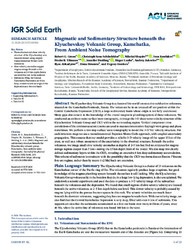Magmatic and Sedimentary Structure beneath the Klyuchevskoy Volcanic Group, Kamchatka, From Ambient Noise Tomography
Luehr, Birger
Abkadyrov, Ilyas
Droznin, Dima
Gordeev, Evgeny
DOI: https://doi.org/10.1029/2019JB018900
Persistent URL: http://resolver.sub.uni-goettingen.de/purl?gldocs-11858/8519
Persistent URL: http://resolver.sub.uni-goettingen.de/purl?gldocs-11858/8519
Green, Robert G.; Sens‐Schönfelder, Christoph; Shapiro, Nikolai; Koulakov, Ivan; Tilmann, Frederik; Dreiling, Jennifer; Luehr, Birger; Jakovlev, Andrey; Abkadyrov, Ilyas; Droznin, Dima; Gordeev, Evgeny, 2020: Magmatic and Sedimentary Structure beneath the Klyuchevskoy Volcanic Group, Kamchatka, From Ambient Noise Tomography. In: Journal of Geophysical Research: Solid Earth, Band 125, 3, DOI: 10.1029/2019JB018900.
 |
Dokument öffnen: |
The Klyuchevskoy Volcanic Group is a cluster of the world's most active subduction volcanoes, situated on the Kamchatka Peninsula, Russia. The volcanoes lie in an unusual off‐arc position within the Central Kamchatka Depression (CKD), a large sedimentary basin whose origin is not fully understood. Many gaps also remain in the knowledge of the crustal magmatic plumbing system of these volcanoes. We conducted an ambient noise surface wave tomography, to image the 3‐D shear wave velocity structure of the Klyuchevskoy Volcanic Group and CKD within the surrounding region. Vertical component cross correlations of the continuous seismic noise are used to measure interstation Rayleigh wave group and phase traveltimes. We perform a two‐step surface wave tomography to model the 3‐D Vsv velocity structure. For each inversion stage we use a transdimensional Bayesian Monte Carlo approach, with coupled uncertainty propagation. This ensures that our model provides a reliable 3‐D velocity image of the upper 15 km of the crust, as well as a robust assessment of the uncertainty in the observed structure. Beneath the active volcanoes, we image small slow velocity anomalies at depths of 2–5 km but find no evidence for magma storage regions deeper than 5 km—noting the 15 km depth limit of the model. We also map two clearly defined sedimentary layers within the CKD, revealing an extensive 8 km deep sedimentary accumulation. This volume of sediments is consistent with the possibility that the CKD was formed as an Eocene‐Pliocene fore‐arc regime, rather than by recent (<2 Ma) back‐arc extension. Plain Language Summary:
The Klyuchevskoy Volcanic Group is a cluster of 13 volcanoes on the Kamchatkan corner of the Pacific ring of fire. The volcanoes regularly produce large eruptions, but good knowledge of the magma plumbing system beneath the surface is still lacking. Why the Klyuchevskoy Volcanic Group volcanoes lie in the location they do, in a large low‐lying depression, is also unexplained. We undertook a seismic experiment and used the data to produce a 3‐D velocity image of the subsurface beneath the volcanoes and the depression. We found that small regions of slow seismic velocity are located beneath the active volcanoes, at 2–5 km depth below sea level. This slower velocity is probably caused by magma lying within the porous fracture spaces in this rock. The seismic velocities are much faster beneath the dormant volcanoes, suggesting they have no magma beneath them. With our velocity image, we also find that the Central Kamchatka Depression is very deep, filled with over 8 km of sediments. This supports an idea that the sediments accumulated as a fore‐arc basin over many millions of years, since 40 Ma, when the active line of volcanoes was found 100 km to the west. Key Points:
Three‐dimensional shear velocity structure of the Klyuchevskoy area was determined using coupled transdimensional Monte Carlo inversions.
Slow velocity anomalies suggest magma storage beneath active volcanoes at 2–5 km depth (below sea level) but not in the midcrust.
Sediments filling the Central Kamchatka Depression are 8 km deep, consistent with an origin of the depression as a fore‐arc basin.
Statistik:
ZugriffsstatistikSammlung:
Schlagworte:
tomographyCentral Kamchatka Depression
transdimensional
Bayesian
ambient noise
Klyuchevskoy Volcanic Group
This is an open access article under the terms of the Creative Commons Attribution License, which permits use, distribution and reproduction in any medium, provided the original work is properly cited.

